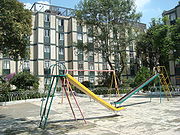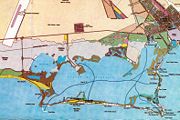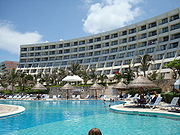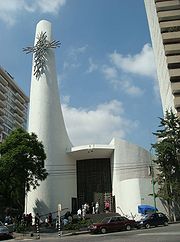
Agustín Landa Verdugo
Encyclopedia
Agustín Landa Verdugo was a Mexican
architect
and urban planner
, born in Mexico City
. He studied architecture in the National University of Mexico (now UNAM
). In 1945 he established a firm with his brother Enrique, with whom he designed hundreds of public and private buildings during four decades of partnership. The firm's work distinguished itself by its modern language and the efficiency and economy of the solutions it proposed.
The work of Landa Verdugo's firm was influential in many areas of architecture in Mexico, including the design of hospitals and social housing, where its pioneering designs became standards for younger architects.
As an urban planner, Agustin Landa Verdugo was the author of the master plan of a number of new cities and neighborhoods in Mexico, most notably the city of Cancún
, which was built in the early 1970s in an uninhabited island in the state of Quintana Roo
.
(IMSS) in cities such as Delicias, Chih.
, and Puebla, Pue.
, built between 1952 and 1956. The experience gained in these projects would prove valuable when, in 1959, the government requested from his firm the design of a network of fifty-five health facilities in Mexico City.
The Institute for Social Security and Services for State Workers
(ISSSTE) assumed the responsibility to provide health services for its members in 1958. For this purpose, it needed hospitals and clinics that would satisfy the large demand. Landa Verdugo thus conceived a large, central hospital with 600 beds, named Hospital 20 de Noviembre, as well as six smaller hospitals and forty-eight clinics, built after two standard models. The hospitals and clinics included, in addition to their medical functions, pharmacies and day-care centers.
According to architecture critic Miquel Adria, the Hospital 20 de Noviembre is one of the "25 most significant buildings from the 20th century in Mexico".
and inaugurated in 1964, consists of 76 four-story slabs in a large plot of land surrounded by wide avenues and with no internal circulations for cars. Instead, circulations are pedestrian, and large areas are destined for gardens, schools and commercial spaces.
The buildings in Loma Hermosa are made of traditional masonry and concrete columns integrated into the walls. This proved to be an efficient layout and structure, and it was repeated by the state's housing agencies in many of the social housing complexes built in Mexico City and other parts of the country during the 1960s.
 Between 1965 and 1967, Landa Verdugo designed a new housing unit known as Lomas de Sotelo, with 2,090 apartments. He used a similar layout and structure as that of Loma Hermosa, and again included a school and a commercial area in the complex. Other complexes from this time include the Cuitlahuac, Xotepingo and Vicente Guerrero housing blocks, all of them in Mexico City.
Between 1965 and 1967, Landa Verdugo designed a new housing unit known as Lomas de Sotelo, with 2,090 apartments. He used a similar layout and structure as that of Loma Hermosa, and again included a school and a commercial area in the complex. Other complexes from this time include the Cuitlahuac, Xotepingo and Vicente Guerrero housing blocks, all of them in Mexico City.
In the later part of his career, Agustín Landa Verdugo began experimenting with different spatial organizations in his housing units. Two projects from the seventies, commissioned by INFONAVIT, are the Ejército Nacional and Pedregal de Carrasco housing units. These projects consist of modules of six by six meters that are organized in patterns that respond to the topography and shape of lots where they were built.
The Ejército Nacional unit, finished in 1974, is of special interest because it was built on an unused plot of land inside a city block. It is one of the first infills in the history of Mexican architecture. This project was part of a strategy by INFONAVIT, the country's main public housing agency, called "Aprovechamiento de terrenos baldíos urbanizados" (Taking advantage of abandoned urban plots).
thus commissioned Landa Verdugo's firm to conceive a new city, in an agricultural valley to the north-east of Mexico City. The commission included the design of the urban layout as well as housing, commercial spaces and the facilities for two of the factories that would operate in the new city.
 In the late 1960s, Landa Verdugo's firm undertook other ambitious urban design projects. Hired by the Bank of Mexico, the architect was a member of the committee that selected the sites for new tourist centers in the Mexican coast. The sites that were chosen were Cancún
In the late 1960s, Landa Verdugo's firm undertook other ambitious urban design projects. Hired by the Bank of Mexico, the architect was a member of the committee that selected the sites for new tourist centers in the Mexican coast. The sites that were chosen were Cancún
, Ixtapa
, in the coast of the state of Guerrero, Huatulco
, in Oaxaca, and Los Cabos
and Loreto
in the state of Baja California Sur.
Agustin Landa Verdugo's firm then began drawing the plans of the new tourist centers. In the case of Cancún, since there was no town in the site selected, the city was built from scratch. Ixtapa, on the other hand, was built next to the preexisting town of Zihuatanejo
. Both projects contemplated areas for hotels, a convention center, luxury housing, golf courses as well as housing and services for the city's permanent population.
 The master plan of Cancún consists of a 12-kilometer strip of hotels on a narrow island surrounded by the Caribbean on one side, and a lagoon on the other. The city of Cancún is located on firm land, to the north-west of the island, and is organized in super-blocks with irregular shapes. Each of these super-blocks has internal pedestrian circulations, large park areas and a core with basic services.
The master plan of Cancún consists of a 12-kilometer strip of hotels on a narrow island surrounded by the Caribbean on one side, and a lagoon on the other. The city of Cancún is located on firm land, to the north-west of the island, and is organized in super-blocks with irregular shapes. Each of these super-blocks has internal pedestrian circulations, large park areas and a core with basic services.
In addition to the master plan, Landa Verdugo designed Cancún's first hotel, Hyatt
Cancún Caribe, the control tower and hall of the temporary airport that was used during the construction of the city, from 1969 to 1974, and the first houses and camping grounds that were used by the engineers and construction workers that first arrived to work in Cancún.
Landa Verdugo's firm also worked on projects for other tourist cities. From 1974 on, however, these were developed within the government agency that coordinated these projects (FONATUR).
 Other notable projects by architect Agustín Landa Verdugo include the French Parish in Mexico City, for the French Catholic Community, the original facilities of the National Free Textbook Commission (CONALITEG) of the Secretariat of Public Education, and an unbuilt proposal from 1967 to build a new international airport for Mexico City in the town of Zumpango.
Other notable projects by architect Agustín Landa Verdugo include the French Parish in Mexico City, for the French Catholic Community, the original facilities of the National Free Textbook Commission (CONALITEG) of the Secretariat of Public Education, and an unbuilt proposal from 1967 to build a new international airport for Mexico City in the town of Zumpango.
, Javier Solórzano and Imanol Ordorika. The latter two worked in Landa Verdugo's firm as workshop leaders.
In addition to his architecture practice and his work in the university, Landa Verdugo led the Bank of Mexico's housing fund (FOVI) from 1963 to 1964, and participated in the creation of the national tourism fund (FONATUR).
In 1990, Agustín Landa Verdugo received the silver medal in the first Mexican architecture biennale for a convent built in Huixquilucan.
Mexican people
Mexican people refers to all persons from Mexico, a multiethnic country in North America, and/or who identify with the Mexican cultural and/or national identity....
architect
Architect
An architect is a person trained in the planning, design and oversight of the construction of buildings. To practice architecture means to offer or render services in connection with the design and construction of a building, or group of buildings and the space within the site surrounding the...
and urban planner
Urban planner
An urban planner or city planner is a professional who works in the field of urban planning/land use planning for the purpose of optimizing the effectiveness of a community's land use and infrastructure. They formulate plans for the development and management of urban and suburban areas, typically...
, born in Mexico City
Mexico City
Mexico City is the Federal District , capital of Mexico and seat of the federal powers of the Mexican Union. It is a federal entity within Mexico which is not part of any one of the 31 Mexican states but belongs to the federation as a whole...
. He studied architecture in the National University of Mexico (now UNAM
Unam
UNAM or UNaM may refer to:* National University of Misiones, a National University in Posadas, Argentina*National Autonomous University of Mexico , the large public autonomous university based in Mexico City...
). In 1945 he established a firm with his brother Enrique, with whom he designed hundreds of public and private buildings during four decades of partnership. The firm's work distinguished itself by its modern language and the efficiency and economy of the solutions it proposed.
The work of Landa Verdugo's firm was influential in many areas of architecture in Mexico, including the design of hospitals and social housing, where its pioneering designs became standards for younger architects.
As an urban planner, Agustin Landa Verdugo was the author of the master plan of a number of new cities and neighborhoods in Mexico, most notably the city of Cancún
Cancún
Cancún is a city of international tourism development certified by the UNWTO . Located on the northeast coast of Quintana Roo in southern Mexico, more than 1,700 km from Mexico City, the Project began operations in 1974 as Integrally Planned Center, a pioneer of FONATUR Cancún is a city of...
, which was built in the early 1970s in an uninhabited island in the state of Quintana Roo
Quintana Roo
Quintana Roo officially Estado Libre y Soberano de Quintana Roo is one of the 31 states which, with the Federal District, comprise the 32 Federal Entities of Mexico. It is divided in 10 municipalities and its capital city is Chetumal....
.
Hospitals
Some of the earliest major projects by Landa Verdugo were public hospitals for the Mexican Social Security InstituteMexican Social Security Institute
The Mexican Social Security Institute is a governmental organization that attends to public health, pensions and social security in Mexico operating under Secretaría de Salud .-History:...
(IMSS) in cities such as Delicias, Chih.
Delicias, Chihuahua
Delicias is a city in the Mexican state of Chihuahua and serves as the seat of the municipality of the same name. It is located southeast of the state capital, Chihuahua. Delicias was declared an official municipality of the state of Chihuahua on January 7, 1935...
, and Puebla, Pue.
Puebla, Puebla
The city and municipality of Puebla is the capital of the state of Puebla, and one of the five most important colonial cities in Mexico. Being a planned city, it is located to the east of Mexico City and west of Mexico's main port, Veracruz, on the main route between the two.The city was founded...
, built between 1952 and 1956. The experience gained in these projects would prove valuable when, in 1959, the government requested from his firm the design of a network of fifty-five health facilities in Mexico City.
The Institute for Social Security and Services for State Workers
Institute for Social Security and Services for State Workers
The Institute for Social Security and Services for State Workers is a governmental organization in Mexico that administers part of Mexico's health care and social security systems, and provides assistance in cases of disability, old age, risks in labor, and death...
(ISSSTE) assumed the responsibility to provide health services for its members in 1958. For this purpose, it needed hospitals and clinics that would satisfy the large demand. Landa Verdugo thus conceived a large, central hospital with 600 beds, named Hospital 20 de Noviembre, as well as six smaller hospitals and forty-eight clinics, built after two standard models. The hospitals and clinics included, in addition to their medical functions, pharmacies and day-care centers.
According to architecture critic Miquel Adria, the Hospital 20 de Noviembre is one of the "25 most significant buildings from the 20th century in Mexico".
Housing Units
Soon after his work for the ISSSTE, Landa Verdugo began working on ambitious public housing complexes. The first of such complex was Loma Hermosa, in Mexico City, with 1,648 apartments for bureaucrats. The project, funded by the Inter-American Development BankInter-American Development Bank
The Inter-American Development Bank is the largest source of development financing for Latin America and the Caribbean...
and inaugurated in 1964, consists of 76 four-story slabs in a large plot of land surrounded by wide avenues and with no internal circulations for cars. Instead, circulations are pedestrian, and large areas are destined for gardens, schools and commercial spaces.
The buildings in Loma Hermosa are made of traditional masonry and concrete columns integrated into the walls. This proved to be an efficient layout and structure, and it was repeated by the state's housing agencies in many of the social housing complexes built in Mexico City and other parts of the country during the 1960s.

In the later part of his career, Agustín Landa Verdugo began experimenting with different spatial organizations in his housing units. Two projects from the seventies, commissioned by INFONAVIT, are the Ejército Nacional and Pedregal de Carrasco housing units. These projects consist of modules of six by six meters that are organized in patterns that respond to the topography and shape of lots where they were built.
The Ejército Nacional unit, finished in 1974, is of special interest because it was built on an unused plot of land inside a city block. It is one of the first infills in the history of Mexican architecture. This project was part of a strategy by INFONAVIT, the country's main public housing agency, called "Aprovechamiento de terrenos baldíos urbanizados" (Taking advantage of abandoned urban plots).
Urban Planning
The first major urban planning project by Landa Verdugo was the master plan of Ciudad Sahagún, in the state of Hidalgo. In the early fifties, as the country's economy was rapidly industrialized, new spaces for large factories were required, outside the saturated major cities of the country. President Miguel AlemánMiguel Alemán Valdés
Miguel Alemán Valdés served as the President of Mexico from 1946 to 1952.-Life:Alemán was born in Sayula in the state of Veracruz as the son of General Miguel Alemán González and Tomasa Valdés Ledezma...
thus commissioned Landa Verdugo's firm to conceive a new city, in an agricultural valley to the north-east of Mexico City. The commission included the design of the urban layout as well as housing, commercial spaces and the facilities for two of the factories that would operate in the new city.

Cancún
Cancún is a city of international tourism development certified by the UNWTO . Located on the northeast coast of Quintana Roo in southern Mexico, more than 1,700 km from Mexico City, the Project began operations in 1974 as Integrally Planned Center, a pioneer of FONATUR Cancún is a city of...
, Ixtapa
Ixtapa
Ixtapa is a beach resort in the municipality of Zihuatanejo de Azueta, in the Mexican state of Guerrero. It is located to the northwest of the municipal seat, Zihuatanejo, and some northwest of Acapulco....
, in the coast of the state of Guerrero, Huatulco
Huatulco
Huatulco , centered on the town of La Crucecita, is a tourist development in Mexico. It is located on the Pacific coast in the state of Oaxaca. Huatulco's tourism industry is centered on its nine bays thus the name Bahias de Huatulco but has since been unofficially shortened to simply Huatulco...
, in Oaxaca, and Los Cabos
Los Cabos
Los Cabos is a municipality located at the southern tip of Mexico's Baja California Peninsula, in the state of Baja California Sur. It encompasses the towns of Cabo San Lucas and San José del Cabo , as well as the Resort Corridor that lies between the two...
and Loreto
Loreto, Baja California Sur
Loreto was the first Spanish settlement on the Baja California Peninsula. It served as the capital of Las Californias from 1697 to 1777, and is the current seat of the municipality of Loreto in the Mexican state of Baja California Sur...
in the state of Baja California Sur.
Agustin Landa Verdugo's firm then began drawing the plans of the new tourist centers. In the case of Cancún, since there was no town in the site selected, the city was built from scratch. Ixtapa, on the other hand, was built next to the preexisting town of Zihuatanejo
Zihuatanejo
Zihuatanejo or Ixtapa-Zihuatanejo, is the fourth-largest city in the Mexican state of Guerrero. Politically the city belongs to the municipality of Zihuatanejo de Azueta in the western part of Guerrero, but both are commonly referred to as Zihuatanejo...
. Both projects contemplated areas for hotels, a convention center, luxury housing, golf courses as well as housing and services for the city's permanent population.

In addition to the master plan, Landa Verdugo designed Cancún's first hotel, Hyatt
Hyatt
Hyatt Hotels Corporation , is an international operator of hotels.Hyatt Center is the headquarters for Hyatt corporation...
Cancún Caribe, the control tower and hall of the temporary airport that was used during the construction of the city, from 1969 to 1974, and the first houses and camping grounds that were used by the engineers and construction workers that first arrived to work in Cancún.
Landa Verdugo's firm also worked on projects for other tourist cities. From 1974 on, however, these were developed within the government agency that coordinated these projects (FONATUR).
Other Notable Projects

Other Assignments
Agustín Landa Verdugo taught at the National University of Mexico for twenty years, from 1948 to 1968. Together with his brother, he presided over one of the school's architecture workshops (Taller 5). Among their students were noted architects and planners Rodolfo Barragán SchwarzRodolfo Barragán Schwarz
Rodolfo Barragán Schwarz is a Mexican architect.Barragán studied at the ITESM, and later under Paul Rudolph at Yale School of Architecture...
, Javier Solórzano and Imanol Ordorika. The latter two worked in Landa Verdugo's firm as workshop leaders.
In addition to his architecture practice and his work in the university, Landa Verdugo led the Bank of Mexico's housing fund (FOVI) from 1963 to 1964, and participated in the creation of the national tourism fund (FONATUR).
In 1990, Agustín Landa Verdugo received the silver medal in the first Mexican architecture biennale for a convent built in Huixquilucan.

